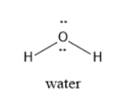
Concept explainers
(a)
Interpretation: The structural formulas of nitrogen, oxygen, carbon dioxide and water vapor needs to be drawn including the lone pair of electrons.
Concept Introduction :
To draw the structural formulas and Lewis dot structure of the molecules, count the total number of valence electrons of all the constituent atoms.
Arrange the electrons around each atom in such a way that each atom should get eight electrons around it.
Lone pair of electrons does not participate in
Due to the presence of lone pair of electrons, the molecule deviates from its regular shape and exhibits polarity.
(a)
Explanation of Solution
Nitrogen structure N2:
The total number of valence electrons in N2 is 5+5 = 10
Structure of N2:

Nitrogen is a linear molecule.
Oxygen: Total number of valence electrons in oxygen is 6+6 =12.
Arrange these electrons in such a way that each atom should be surrounded by eight electrons.

Oxygen is a linear molecule.
Water Vapor:
Valence electrons in oxygen atom are 6.
Hydrogen has one valence electron.
Total water has 6+2=8 electrons.
Arrange them in such a way that oxygen should get 8 electrons around it and hydrogen should get two electrons.

Water has bent shape.
Carbon dioxide:
Carbon has four valence electrons.
Oxygen has six valence electrons.
Total number of valence electrons = 4+ 6+6=16 electrons.
Structure of CO2:

Carbon dioxide is a linear molecule.
(b)
Interpretation: The Lewis structure of water needs to be drawn.
Concept Introduction: To draw Lewis dot structure of water, count the total number of valence electrons of all the constituent atoms.
Then, arrange the electrons around each atom in such a way that oxygen should have eight electrons and hydrogen has two electrons.
(b)
Explanation of Solution
Valence electrons in oxygen atom are 6.
Hydrogen has one valence electron.
Total water has 6+2=8 electrons.
Arrange them in such a way that oxygen should get 8 electrons around it and hydrogen should get two electrons.

(c)
Interpretation: Polar and non-polar molecules among nitrogen, oxygen, water and carbon dioxide needs to be determined.
Concept Introduction:
In Lewis dot structure the central atoms that carry lone pair of electrons are polar.
(c)
Explanation of Solution
Nitrogen is a polar molecule, since nitrogen has a lone pair.
Oxygen is a polar molecule, since oxygen has two lone pairs of electrons.
Water is a polar molecule, since oxygen has two lone pairs of electrons.
Carbon dioxide is a nonpolar molecule, since dipole moment of C-O polar bond cancels on each direction.
(d)
Interpretation: Natural occurrence of these molecules needs to be explained.
Concept Introduction:
The molecules which have strong intermolecular forces of attraction can exist as solids and then liquid and weak intermolecular forces of attraction make them exist as gases.
(d)
Explanation of Solution
Water exists as a liquid at room temperature due to strong H-bond.
Nitrogen, oxygen and carbon dioxide exist as gases under normal conditions.
Chapter U3 Solutions
Living By Chemistry: First Edition Textbook
Additional Science Textbook Solutions
Chemistry: The Central Science (13th Edition)
Chemistry (7th Edition)
General, Organic, and Biological Chemistry (3rd Edition)
Organic Chemistry
Chemistry: A Molecular Approach (4th Edition)
Organic Chemistry (9th Edition)
 ChemistryChemistryISBN:9781305957404Author:Steven S. Zumdahl, Susan A. Zumdahl, Donald J. DeCostePublisher:Cengage Learning
ChemistryChemistryISBN:9781305957404Author:Steven S. Zumdahl, Susan A. Zumdahl, Donald J. DeCostePublisher:Cengage Learning ChemistryChemistryISBN:9781259911156Author:Raymond Chang Dr., Jason Overby ProfessorPublisher:McGraw-Hill Education
ChemistryChemistryISBN:9781259911156Author:Raymond Chang Dr., Jason Overby ProfessorPublisher:McGraw-Hill Education Principles of Instrumental AnalysisChemistryISBN:9781305577213Author:Douglas A. Skoog, F. James Holler, Stanley R. CrouchPublisher:Cengage Learning
Principles of Instrumental AnalysisChemistryISBN:9781305577213Author:Douglas A. Skoog, F. James Holler, Stanley R. CrouchPublisher:Cengage Learning Organic ChemistryChemistryISBN:9780078021558Author:Janice Gorzynski Smith Dr.Publisher:McGraw-Hill Education
Organic ChemistryChemistryISBN:9780078021558Author:Janice Gorzynski Smith Dr.Publisher:McGraw-Hill Education Chemistry: Principles and ReactionsChemistryISBN:9781305079373Author:William L. Masterton, Cecile N. HurleyPublisher:Cengage Learning
Chemistry: Principles and ReactionsChemistryISBN:9781305079373Author:William L. Masterton, Cecile N. HurleyPublisher:Cengage Learning Elementary Principles of Chemical Processes, Bind...ChemistryISBN:9781118431221Author:Richard M. Felder, Ronald W. Rousseau, Lisa G. BullardPublisher:WILEY
Elementary Principles of Chemical Processes, Bind...ChemistryISBN:9781118431221Author:Richard M. Felder, Ronald W. Rousseau, Lisa G. BullardPublisher:WILEY





